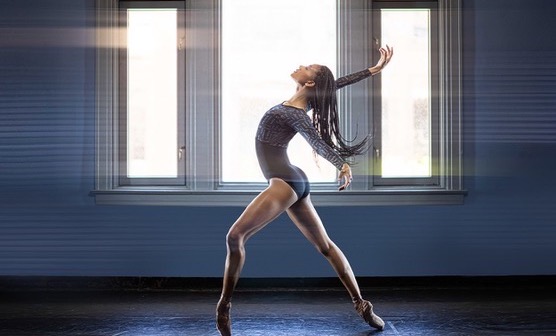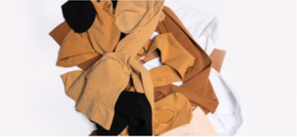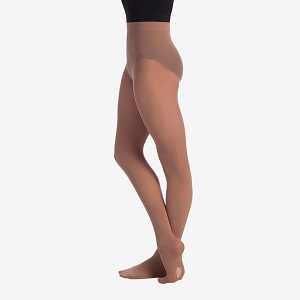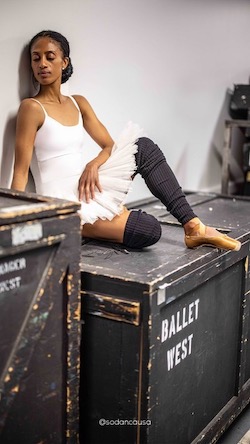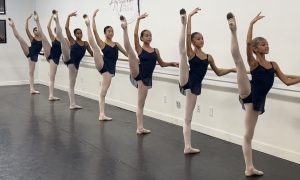Ballet dancers do everything they can to extend their lines, not only through intensive technique and training, but right down to costume cuts and colors. So much of the artform is designed around long lines, so why has it taken so long for classical ballet companies to move away from pale pink tights and pointe shoes? While those might offer continuous lines for white dancers, it actively cuts off the lines of anyone with darker or different skin tones.
Ballet West Principal Dancer Katlyn Addison gave us her input on how much the tone of the tights can affect Black dancers and dancers of color.
“To be completely honest, regarding tights, when I was younger, it never occurred to me to see an issue,” she says. “As a young ballerina, I thought of my pink tights as part of a uniform. Each day, I went to ballet and simply put on my uniform. It wasn’t until I saw a Black dancer wearing tights in her skin color that I noticed the impact of properly matched tights on a dancer’s lines.”
Once aware of the improved aesthetic, Addison become more self-aware of the difference skin tone tights can make. “The flow of the lines from the top of your head to the tip of your toes is dramatically improved when you wear tights in your skin tone. Ballet is about the artistry, aesthetics and expression of the body through movement. It can be very disheartening when you don’t have access to products that match your skin and help create that seamless line.”
When asked how often she’s been given a “nude” costume that was really just beige, Addison responds, “All the time! I have been very fortunate at Ballet West. Our costume shop has always individualized my mesh lining or elastic, but the conversation has always been needed. Whether it’s the mesh lining in the bodice or the ‘nude’ elastics that never seemed available in a dark shades…”
When it comes to dancewear companies that prioritize making products available in a range of skin tones, Só Dança is up front. Kelly McCaughey, Só Dança’s North American sales and marketing director, explains that diversity is ingrained into the company’s origins.
“Só Dança started in Brazil almost 35 years ago,” says McCaughey. “As a company based in a very diverse community, it was only natural to include products that represented all of its dancers and showcase them in our catalogs.” Right from the start, Só Dança’s tights came in a multitude of shades of beige, brown, pink, white and black. “These shades were created for our diverse models who have been a part of our organization for decades. It was something that we did to serve the market before it was requested by society.”
A prime example of Só Dança’s organic diversity is its famed SD16 ballet flat (the first-ever no-drawstring ballet shoe). Launched in 2012, it was immediately available in seven colors and quickly became a popular pick. Só Dança is also continuously expanding its available colors, having recently added Caramel, Suntan and Mocha to its leather shoe options.
Shoes are a particular problem for dancers of color. Flat canvas shoes can be dyed, which is hassle enough. But when it comes to getting pointe shoes to match your skin tone, the structural integrity of the shoes are compromised when they get too wet. Which means each pair, ribbons and all, have to be meticulously hand painted.
“The frustration of having to paint my pointe shoes!” Addison bemoans. “As a student and in early years of my career, I often felt that for me to be successful in a predominately white, classical ballet world, I had to work twice as hard. I always had to do extra work, and painting pointe shoes fell into that category. I had to take extra steps to ensure that the tools of my trade worked for me and my aesthetic rather than against it. I was so grateful that my Artistic Director, Adam Sklute, was open to having conversations about my pointe shoe color shortly after I began dancing with Ballet West and was elevated through the ranks.”
With Só Dança’s multiple options for tights, dancers of color can feel confident in showing off their uninterrupted lines. “As a child, having access to their tights helped me feel more included in the ballet world even though wearing my skin tone was neither popular nor widely accepted,” confirms Addison.
She recalls desperately wanting to wear Só Dança’s ballet flats, but says she wasn’t yet strong enough in her career to “defy odds and wear anything other than the standard color. But,” she says, “thankfully, today we are in a different space. ‘Watch me now!’ I am thankful that it is becoming more accepted in the classical ballet world to take advantage of the variety offered by brands like Só Dança.”
“One important thing for Só Dança is our values and beliefs,” states McCaughey. “Diversity might not have been a popular topic in the past, but it was a part of who we are and will always be.” The company currently sponsors Atlanta Ballet and Ballet West Academy, who both encourage their dancers to wear tights and shoes in their preferred shades. “As a company that produces choice, we couldn’t be happier that they chose us to make their academies more inclusive.”
Só Dança’s history means it has been offering diverse dancewear options well before the need to do so was commercially recognized. “Knowing that their products are available, and have been for years, helps me to feel supported by a reputable dance brand,” says Addison.
But dancers of color deserve more than just one or two brands addressing their needs. More colors in more stores means more diverse dancers supported in an overwhelmingly white art form. That support allows them to be, as Addison puts it, unapologetically themselves.
When asked if she hopes brands like Só Dança will keep increasing the variety of skin tones in their collection, Addison energetically responds, “Yes, please! The more shades the better. I would love for every dancer to be able to find what they need.”
You can follow Katlyn Addison on Instagram: @katlynaddison.
By Holly LaRoche of Dance Informa.


